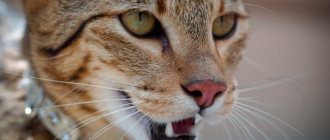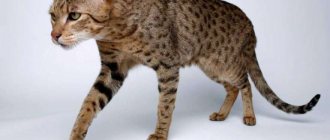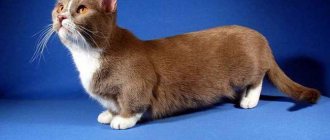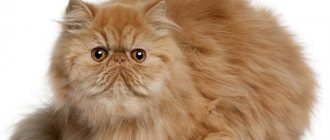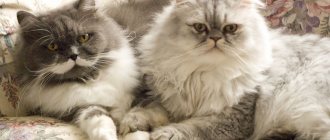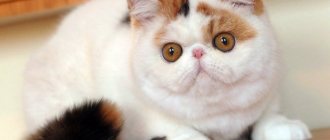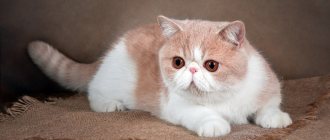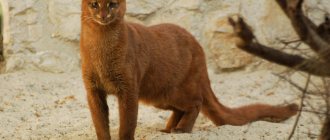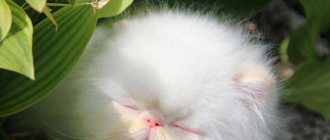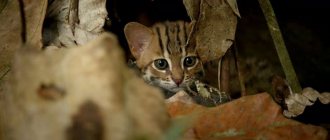One of the most popular breeds in the world is the Persian cat . Persians are loved not only for their exceptionally chic and beautifully colored fur coat, but also for their wonderful peace-loving character. Keeping such a four-legged friend in the house is true happiness for a person who loves cats. Of course, such happiness requires increased attention precisely because of its external characteristics: the structural features of the jaw and the physiology of the cat do not tolerate a careless approach to nutrition, and grooming is a serious and obligatory procedure. But this does not stop those who want to have such a fluffy and affectionate beauty in their home.
Origin story
The history of the Persians - the aristocrats of the cat family - goes back to ancient times. The very first images of furry babies were found in the ruins of Persepolis and Susa, which means that they lived in the courts of the first kings - Darius and Cambyses.
In the 17th century, several individuals with amazingly long hair were taken from Isfahan (a city in Iran) to Italy by aristocratic traveler Pietro della Valle. Their traces were soon lost, and who knows how history would have turned out if Della Valle had not written about the amazing discovery to the French scientist Nicole-Claude Farby, a fanatical cat lover.
The latter, unable to contain his curiosity, personally went to Isfahan and took several luxurious Turkish Angora cats to France. The local aristocracy was conquered, including the notorious Cardinal Richelieu. Thanks to his patronage, long-haired cats became wildly popular: the local aristocracy began to race to have them in their own homes. Cats were called differently: French, Turkish, oriental.
Soon cats came to England and were so loved by the British that in 1887 the National Cat Club was organized in Great Britain and the first general standards were developed. Felinologists divided long-haired cats into 2 breeds: Turkish Angoras and French cats (gradually the name changed to Persian).
In the 20th century, Persians came to the United States and breeders rolled up their sleeves and began to work to improve their decorative features. The classic “British” version was changed and the so-called “extreme” type was born: with widely spaced eyes, an overhanging forehead, a short snub nose and deep folds near the eyes and mouth.
There is another opinion: long-haired cats supposedly appeared on the territory of Russia, as evidenced by their long, thick hair (without this they cannot survive in a harsh climate). And the animals were already taken from us to the East. But no even the slightest evidence of this has yet been found; this version bears little resemblance to the real one.
Friendliness
Persian cats have a friendly, affectionate character. People call them cat intellectuals. Intrusiveness or persistence is not in their nature. A Persian cat will not meow loudly when begging for a treat. The pet will sit decorously next to you and wait for attention to be paid to it.
In any situation, the Persians will show peacefulness and try to avoid conflict. Aggressive attacks are very rare and are committed only in self-defense or in a state of severe fright. Its cause may be irritation or anger on the part of the owners, whom the pet trusts infinitely. A Persian cannot be picked up by the withers. His paws need constant support.
Standards
Based on appearance, the Persian cat is conventionally divided into 4 types:
- classic (nose located slightly below eye level);
- modern type (the edge of the nose intersects with the border of the lower eyelid, while the eyes have the shape of a circle);
- American (extreme) type: the nose is in line with the inner corners of the eyes, and seems to be concave inward;
- exotic (short-haired type): external characteristics correspond to general standards, the only difference is short hair.
| Standard | Description |
| Head | Large, dome-shaped, with a convex forehead. The cheeks are round and thick. The cheekbones are dense and powerful. The stop on the nose is clearly marked, the nose itself is wide and very short, most often snub-nosed (in individuals of the “Pekingese” type it is depressed). The muzzle is round and wide. The chin is weakly defined, the jaws are well developed. |
| Eyes | Large and round, widely spaced. The colors can be any, but, according to the standard, golden, silver and chinchilla cats should have only green shades, color-point cats should have blue shades, and Persians of any color should have orange and copper shades. |
| Ears | Small and neat, widely spaced, their tips rounded. The inner part is pubescent. |
| Neck | Short and powerful, with well-developed muscles. The body is the same: massive, with a wide back and strong bones. |
| Paws | Powerful, stocky, straight boned. The paw pads are round and elastic. Hair grows in tufts between the toes. |
| Tail | Short, outwardly proportional to the body, thick and covered with thick hair. Its tip is rounded. |
| Wool | Soft and shiny, can reach 12 cm in length on the body and up to 15 cm on the “collar”. Doesn't fit to the body. |
The disadvantages of the standard are: slanted and small eyes; a long tail; long legs and torso; long toes; oval paw shape; a long nose; large and close-set ears; narrow head.
Disqualifying signs: “medallion” on the chest; obvious jaw defects; knobby tail.
In the photo there are kittens of the Persian breed
Attitude towards other animals
Being phlegmatic, the Persian cat gets along peacefully with other inhabitants of the apartment - a cat, a dog or even a parrot. The relationship between a Persian and a dog is often built on the basis of some kind of rivalry: the animals try to win the attention of the owner. An elderly dog may experience maternal feelings towards a kitten, caring for, protecting and tolerating the pranks of the little fidget.
Much of how the relationship between four-legged pets in a family will be built depends on the owner. He must make it clear that hostility between animals is unacceptable, giving each an equal amount of attention and care. If the wards do not show aggression towards each other, praise will be a good incentive for them.
Experts recommend keeping them at a distance for some time after animals appear in the house, allowing them to get used to it. Adaptation lasts about a week. If the animals ate from the same bowl for the first time or settled down to sleep on a common bedding, this indicates that the partnership is gradually improving.
Weight table
The weight of a Persian cat ranges from 3.5 to 7 kg. Females weigh slightly less than males. Weight table for Persian cats by month
| Age | Cat | Cat |
| newborn | 90-130 gr | 100-150 gr |
| 1 month | 390-460 gr | 410-530 gr |
| 2 months | 560-920 gr | 700-1100 gr |
| 3 months | 1-1.5 kg | 1.2-2 kg |
| 4 months | 1.4-2.3 kg | 1.7-3 kg |
| 5 months | 2-2.6 kg | 2.1-3.6 kg |
| 6 months | 2.2-3.4 kg | 2.6-4.4 kg |
| 8 months | 2.7-4.2 kg | 3.6-5 kg |
| 10 months | 3-4.5 kg | 4-5.9 kg |
| 1 year | 3.5-5 kg | 4.6-6.6 kg |
| 2 years | 3.8-5 kg | 5.2-7 kg |
Buying a kitten
You should purchase a Persian kitten from a nursery that specializes in breeding animals of this breed if the goal is to purchase a purebred Persian with documents and pedigree. It will cost from 20 to 50 thousand rubles and more. If the animal is purchased for breeding, the price will be even higher.
You can buy a kitten in the following nurseries:
- Lumicat (Moscow);
- Barland Rus (Moscow);
- C-Matrix (Rostov-on-Don);
- Fleur de Mireille (Moscow).
However, if you want to have a beautiful kitten without overpaying, you can buy it from private breeders. He will not have a pedigree and titled parents, but he will cost a symbolic 2-5 thousand rubles. When purchasing, you should pay attention to the eyes and nose of the kitten. There should be no defects. The baby should be active and eat with appetite. The coat should be shiny and silky. The eyes of a small kitten (up to 1.5 months) may be slightly squinted. This will pass with time.
Colors
In terms of the number of color types, the Persian cat will give odds to all other breeds, and all of them are officially recognized.
According to the exhibition rules, they are divided into 5 types:
- Single color;
- Smoky tabbies;
- Shaded;
- Partially painted;
- Point colors.
The photo shows a white Persian cat.
Common shades:
- The coat is black, the eyes are copper or orange. Impurities of a different color are not allowed, and patterns are not allowed. There may be a gray undercoat.
- Blue-eyed color-point with the obligatory cream shade of the body.
- Snow white with blue or orange eyes.
- Blue with yellow eyes.
- Fawn-cream color, copper color. Eyes the color of the fur. The presence of spots on the fur is not allowed.
- Red – rich, uniform orange with copper eyes.
- Bluish cream with copper eyes.
- Snow-white, apricot or smoky silver coat with brown or black tips. The eyes are green, outlined in black. The same subgroup includes lilac, blue and chocolate chinchillas.
- Persian Cameo (color can be yellow, cream or tortoiseshell) with copper-colored eyes.
- Smoky color, light silver undercoat. The eyes are orange.
- Two-color Persians, one of the colors must be white (no more than 50% of the total color). Copper eyes. A small number of colored spots are allowed.
- Tabby - silver, brown, red, chocolate, lilac, blue. Eyes copper, brown, emerald.
- Tortoiseshell color: a combination of spots of blue, chocolate, black, red and cream. Copper eyes. Mixing with white is allowed. The muzzle may have a red or cream tint.
- Pewter (pewter) - a mixture of white with shadows on the back and paws. The eyes are outlined in black and light orange.
- Pale lilac with a pink tint, copper eyes, outlined in black.
- Chocolate color of different shades, copper eyes.
- Marbled black with dark orange or copper eyes. The eyes are lined with black.
- Ivory color with bluish ticking, eyes lined, orange or copper.
- Black Spotted: The spots are oval or round, evenly distributed over the body, the eyes are outlined in black. Eye color is copper or dark orange.
- Black marbled with a silver body tint. The eyes are copper, outlined in black.
- Snow-white undercoat with a dark tint, green eyes of all shades, eyes outlined in dark.
In the photo there is a gray Persian cat
Gallery of photos of Persian cats
Solid colors
red
black
white
blue
lilac
chocolate
Bicolor - two-color
red bicolor
black bicolor
Blue bicolor
Lilac bicolor
Tabby
red tabby
black marble
brown tabby
golden tabby
red marble
Color point and smoky
black smoke
blue smoke
chocolate smoke
color point
color point
Chinchillas and turtles
golden chinchilla
silver chinchilla
tortoiseshell
calico
Character and behavior
A Persian cat, like any other, once in a family, looks for a leader, a dominant, to whom it will obey for the rest of its life. Representatives of this breed themselves do not know how to be a leader, but they also do not want to remain at the bottom rung of the family hierarchy - they occupy the middle, where they feel quite comfortable. Accordingly, the Persians obey one person, and simply bestow their attention on the rest.
It is believed that males more often choose a woman as an owner, and cats - a man.
A smart and intelligent cat does not like fuss and is never in a hurry. This is a true phlegmatic: slow, thoughtful, with smooth movements - as they say, “on his own mind.” The little Persian doesn’t mind chasing a ball around the rooms, jumping on chairs and tables, playing tag, but as he gets older, he will prefer more interesting pastimes. As one well-known aphorism says, if you communicate with a kitten as with an adult, and with an adult as with a rational being, your Persian will not be inferior in intelligence even to a German shepherd.
Many Persian owners claim that the cat understands them literally. What they prefer most is communication with family members. If you talk to her often and affectionately, your kitty will understand that she is needed and loved. This breed is not suitable for fussy, active and active people.
Persians do not really like to sit on their hands, preferring to receive their portion of affection by sitting down at a distance. Inactive, meows rarely, loves to lie on the window for a long time and watch what is happening on the other side of the glass. But he is afraid to walk down the street. He communicates calmly with all pets: be it a dog, another cat, a parrot or a small rodent. Unfortunately, there are no Persian hunters.
They treat strangers with distrust. They are loyal to children, but do not tolerate being pulled by the tail. They value comfort and coziness: having chosen a cozy sofa or armchair for themselves, they will be extremely unhappy if someone else encroaches on it.
Mother cats are very caring and, curiously, show absolutely no aggression towards others who want to take a closer look at the babies or pick them up.
How did the cat move in K.I. Chukovsky’s famous poem “The Cockroach”?
jump backwards
Persians are vulnerable and touchy. You cannot raise your voice or raise your hand at them.
Expert opinion
Dusheba Vera Ivanovna
In 2010, she graduated from the Moscow State Academy of Veterinary Medicine named after K.I. Scriabin with honors, specializing in veterinary medicine. I regularly attend veterinary conferences, congresses, and webinars.
Persians are not carried by the withers, only with emphasis on the paws.
Conclusions about the breed
The Persian cat is a worthy pet that will quickly become the beloved youngest child in the family. She will always be close to the owner, without imposing her attention. With the proper level of care, a cat of such a noble breed will live a long life, decorating the owner’s home with its existence. Despite the fact that his fur coat will require daily attention and care will take a lot of time, such a pet will bring a lot of joy to its owners with its affectionate character and devoted attitude towards the family.
global $ads_google; //data-ad-slot=”2475549904″ $ads_google = empty($ads_google) ? false : true; ?> if ($ads_google == false) {?> $ads_google = true; ?> } ?>
Care instructions
The Persian cat requires a lot of attention, as well as significant financial investments. You wouldn't want your luxurious pet to lose all its majestic appearance, would you?
Wool
Caring for a Persian's coat is a real sacred act. You will have to bring a lot of tools: a brush with natural bristles, a rare comb, scissors, and a spray for removing hair. But you don't need a powder brush.
If you do not train yourself to help your cat get rid of excess hair every day, your graceful cat will soon turn into a shapeless thing covered in tangles. And you can only get rid of them in a radical way - with the help of scissors. Therefore, brush your pet every 2 days: turn the pussy over on its back and brush the neck, belly, paws, then the back and head. Sprinkle the fur with grooming powder.
If you teach your Persian to do this while he is small, you will not have any problems with an adult cat.
Teeth and ears
Ear and dental care is standard. The ears should be cleaned every week with a cotton swab dipped in a special lotion, and the teeth should be cleaned thoroughly using a silicone brush and paste for cats (Levrana Love pets, Trixie).
Bathing
Bathing - once a month, during molting - 2 times. Choose a shampoo for long-haired cats: Perfect Coat, Protein-lanolin, Doctor. After bathing your pet in warm water and rinsing off the shampoo, dry the animal first with a towel and then with a hairdryer.
Be careful: Persians, despite their lush coat, catch colds easily. Protect them from drafts for 10-12 hours after the procedure.
Eyes
Clean your eyes daily. Moisten a piece of cotton or flannel fabric with special drops or warm chamomile decoction and clean the discharge from the tear duct. Do not use cotton wool, wet wipes or tap water!
Claws
Nails are trimmed every week using a special nail clipper.
Going to the toilet is a big event for your Persian. They sit there for a long time and also bury their waste for a long time. Buy a tray with high sides, and the filler is granular, not wood.
If you plan to attend exhibitions with your pet, home care will not be enough. You will have to use the services of a professional groomer.
How to choose a kitten
So, you have answered your questions positively: do you want to get a cat, will it be a Persian, and will you have enough time to provide your pet with decent care?
The time has come to choose and purchase a kitten. It is best to resolve the issue of purchasing a purebred Persian through specialized clubs. Experts will help you with your choice, and you are guaranteed to buy a healthy high-breed baby.
If there is no such club in your city, we recommend that you follow the following tips:
Persian cat with kitten
- take the animal only from the mother cat. This way you can evaluate the appearance of the mother, see if she is healthy, and in what conditions she is kept with her kittens. You can ask the owners if the kids are accustomed to the tray, what kind of diet they are accustomed to. Serious breeders must provide you with registration documents (measures or pedigree) for both parents and kittens;
- You can pick up the baby only after he reaches two months. At this age, he already knows how to feed himself and will more easily endure separation from his mother. If you plan to use your Persian cat for breeding and showing in the future, wait until the kitten is three to four months old. At this age, it is already possible to more specifically assess its compliance with the breed standard;
- examine your chosen one. The eyes and ears should be clean, the tummy should be soft. The fur around the anus is clean and dry. There should be no signs of scratching or bald spots on the baby's body. Also make sure there is no unpleasant odor from the mouth;
- It is better to purchase kittens of breeding or show classes together with an expert. He will professionally assess the condition of the animal to ensure it meets the standard and that there are no signs of genetic diseases. You cannot do without the help of a specialist when choosing a Persian kitten of complex color;
Of course, all kittens offered to you must be vaccinated and have documentary evidence of this.
Catering
Both experienced breeders and doctors say one thing: Persians should be fed in accordance with their health and age. From an early age, teach your cat to eat at a certain time.
Natural products
- Kittens feed on demand for up to a month;
- 1-2 months – eat 6 times a day;
- 2-4 months – 4-5 times a day;
- 4-6 months – 3 times;
- From 6 months – 2 times a day.
Daily food intake: 250 g per kilogram of live weight. For an adult cat – 300-350 g.
The first complementary food for a Persian baby is porridge cooked in diluted milk. From 3 months you can give frozen meat (naturally, before eating it is defrosted, doused with boiling water and minced). Serving – 0.4 teaspoon.
From 5 months, fermented milk products (natural yogurt, cottage cheese, low-fat sour cream, kefir, fermented baked milk), quail eggs, chicken yolk, and vegetables are introduced. You can also give children's cereal-vegetable mixtures.
Dry and wet food is allowed from 6 months. At first, the pads can be soaked in broth.
The diet of an adult cat should include:
- Meat (veal, rabbit, lamb, chicken, beef) – 50-60% of the total diet;
- By-products (chicken hearts and kidneys, raw cow stomach);
- Sea fish (salmon, hake, trout, cod) - no more than once a week;
- Vegetables (carrots, beets, green beans, pumpkin, cauliflower, zucchini) – every other day;
- Cheese (unsalted): once a week;
- Porridge (oatmeal, rice, buckwheat, millet, barley, for kittens up to 3 months - liquid semolina) - daily;
- Clean warm water: freely available (it is changed in the mornings and evenings).
Do not give to Persians:
- Milk
- Fatty meat (pork, goose),
- Smoked, salty, sweet, canned,
- Sauces, seasonings, spices,
- Baking,
- Bones and tripe
- Alcohol, carbonated and mineral water,
- Eggplants, potatoes, garlic, onions,
- Fat cottage cheese.
Recommended food
The best industrial food for Persians:
- German food based on poultry meat, vegetables and rice Sanabelle.
- Italian Purina Pro Plan Delicate: food for sensitive digestion (40% protein, there is also a vitamin complex).
- Royal Canin Persian (Royal Canin, France): contains chicken, cereals and vegetables.
- Orijen Cat 6 Fresh Fish comes in the form of granules with a fishy smell that is pleasant to the cat. Contains a vitamin complex.
Expert opinion
Dusheba Vera Ivanovna
In 2010, she graduated from the Moscow State Academy of Veterinary Medicine named after K.I. Scriabin with honors, specializing in veterinary medicine. I regularly attend veterinary conferences, congresses, and webinars.
Industrial feeds are divided into 4 groups: economy, premium, premium and holistic. You should buy economy class food only as a last resort: they are poor in nutrients and protein, contain harmful dyes and additives, and can ruin your pet’s stomach in a short time. Premium food is somewhat richer in composition, but the amount of meat in them is minimal, there are preservatives that are harmful to health, and often cause allergies. Premium class and holistic are the most suitable options: they contain the required amount of protein and fiber, and add all the necessary vitamins and minerals.
Below are recommended super premium foods, links with food names are clickable. Using them, you can, within our website, read descriptions of food and read reviews from owners of the Persian cat breed.
| Premium | Premium | Holistic |
| Pro Plan | Royal Canin Persian | Golden Eagle |
Diseases
Numerous experiments on appearance led to the fact that the Persians began to have serious health problems. The breeders had to backtrack a little, trying to eliminate the shortcomings, which required a lot of effort, time and money. However, modern representatives of the Persian breed cannot boast of good health.
- Polycystic kidney disease is diagnosed in 50% of Persians. If there is no treatment, by the age of 7-9 years the animal will develop kidney failure and die.
- The second most common disease is hypertrophic cardiomyopathy. Unfortunately, in half of the cases, symptoms do not appear until sudden death occurs. Cats get sick more often.
- Retinal atrophy occurs in kittens. The disease develops so quickly that by the age of 4 months the kitten becomes blind.
- Another weak point is teeth. In addition to regular cleanings, you need to take your cat to the veterinarian more often and, if necessary, clean his teeth using special devices.
- Changing your diet causes intestinal upset.
Persian health
All living beings have a tendency to some kind of disease. And this wonderful breed is also susceptible to certain diseases, including polycystic kidney disease. This disease sometimes leads to kidney failure in the cat's advanced age and old age. In order not to miss the first symptoms, you need to monitor the health of your older pet and if you suspect any abnormalities, immediately contact a veterinarian. It makes sense to monitor the heart condition of your breed pet, as sometimes they develop cardiomyopathy. Since the breed is classified as large, it is prone to hip dysplasia.
Timely vaccinations will protect your dog from many health problems. Vaccination of the breed is carried out according to the schedule established by the veterinarian.
After mating, the cat becomes pregnant; the gestation period depends on the number of babies in the belly. Childbirth occurs in 63-66 days. If you do not want offspring from your pet, it needs to be castrated or sterilized at the age of 9-12 months.
Eye care for Persian cats
global $ads_google;
//data-ad-slot=”2475549904″ $ads_google = empty($ads_google) ? false : true; ?> if ($ads_google == false) {?> $ads_google = true; ?> } ?> Most often, owners are worried that the Persian cat’s eyes are watery . Due to the physiology of the structure of the muzzle in this breed, the tear streams are practically blocked, which makes the charming cat a chronic crybaby. If you eliminate this cosmetic defect every day by washing your eyes with a soft, clean cloth, this will eliminate traces of “tears” on the face and make life easier for your pet. It is impossible to treat the problem anyhow, as constant discharge will thin the hair around the eyes, and it will begin to come out.
You can alternate washing your eyes with warm water and treating the area around the eyes with a mixture of boric acid, hydrogen peroxide and starch. Sometimes, even with proper care, brown discharge flows from the cat’s eyes, or the eyes begin to fester: in these cases, do not postpone a visit to a specialist.
How long do Persian cats live?
Since the life of Persian cats takes place at home under the constant control and care of the owner, their cat’s life expectancy is on average 12-17 years
.
If you spay or neuter a cat before one year, their lifespan will increase - with good care, a pet of such a generally strong breed can live up to 20 years
. This is explained by smooth hormonal levels and human care, which also includes specialized nutrition and timely treatment of diseases.
